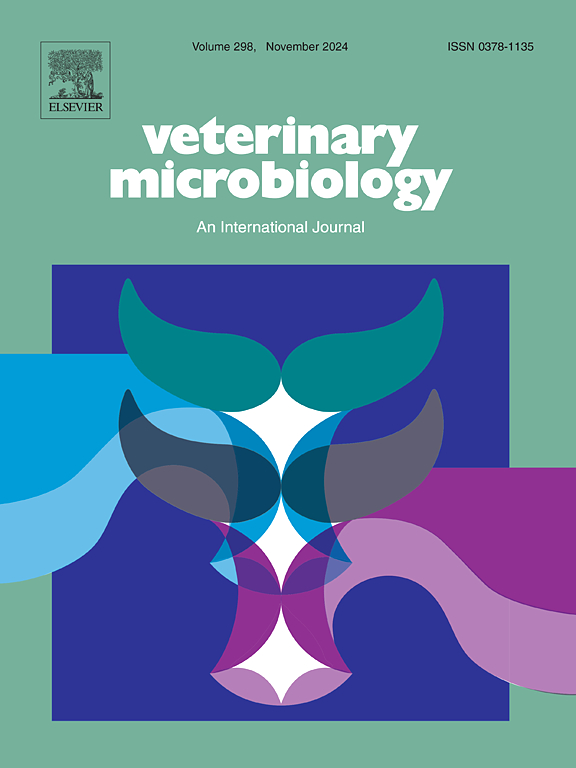锌指抗病毒蛋白(ZAP)通过靶向ORF1、ORF2和ORF3 mRNA抑制PCV2复制
IF 2.7
2区 农林科学
Q3 MICROBIOLOGY
引用次数: 0
摘要
猪圆环病毒2型(PCV2)是断奶后多系统消耗综合征(PMWS)和其他pcv相关疾病(PCVAD)的主要原因。本文报道了由ZC3HAV1基因编码的猪ZAP长异构体(pZAPL)对单链环状DNA病毒PCV2的抗病毒特性。猪ZAP在体内和体外对PCV2感染有应答。值得注意的是,pZAPL的抗病毒活性似乎比pZAP的短异构体(pZAPS)强。进一步的双荧光素酶和RNA免疫沉淀分析表明,pZAPL靶向PCV2的ORF1、ORF2和ORF3 mrna。pZAPL过表达会影响ORF1、ORF2和ORF3 mRNA的稳定性。综上所述,猪ZAPL通过靶向ORF1、ORF2和ORF3的mRNA抑制PCV2的复制。本研究结果进一步拓展了对pZAP在猪抗病毒先天免疫中的作用的认识。本文章由计算机程序翻译,如有差异,请以英文原文为准。
Zinc finger antiviral protein (ZAP) inhibits PCV2 replication by targeting ORF1, ORF2 and ORF3 mRNA
Porcine circovirus type 2 (PCV2) is the primary cause of post-weaning multisystemic wasting syndrome (PMWS) and other PCV-associated diseases (PCVAD). Here we report the antiviral properties of porcine ZAP long isoform (pZAPL), encoded by ZC3HAV1 gene, against PCV2, a single-stranded circular DNA virus. The expression of porcine ZAP responds to PCV2 infection in vivo and in vitro. Notably, the antiviral activity of pZAPL appears to be stronger than short isoform of pZAP (pZAPS). Further dual luciferase and RNA immunoprecipitation analyses showed that pZAPL targeted the ORF1, ORF2 and ORF3 mRNAs of PCV2. Overexpression of pZAPL could impact the mRNA stability of ORF1, ORF2, and ORF3. In summary, porcine ZAPL inhibits the replication of PCV2 by targeting the mRNA of ORF1, ORF2 and ORF3. The findings from this study further extend the understanding of the role of pZAP in porcine antiviral innate immunity.
求助全文
通过发布文献求助,成功后即可免费获取论文全文。
去求助
来源期刊

Veterinary microbiology
农林科学-兽医学
CiteScore
5.90
自引率
6.10%
发文量
221
审稿时长
52 days
期刊介绍:
Veterinary Microbiology is concerned with microbial (bacterial, fungal, viral) diseases of domesticated vertebrate animals (livestock, companion animals, fur-bearing animals, game, poultry, fish) that supply food, other useful products or companionship. In addition, Microbial diseases of wild animals living in captivity, or as members of the feral fauna will also be considered if the infections are of interest because of their interrelation with humans (zoonoses) and/or domestic animals. Studies of antimicrobial resistance are also included, provided that the results represent a substantial advance in knowledge. Authors are strongly encouraged to read - prior to submission - the Editorials (''Scope or cope'' and ''Scope or cope II'') published previously in the journal. The Editors reserve the right to suggest submission to another journal for those papers which they feel would be more appropriate for consideration by that journal.
Original research papers of high quality and novelty on aspects of control, host response, molecular biology, pathogenesis, prevention, and treatment of microbial diseases of animals are published. Papers dealing primarily with immunology, epidemiology, molecular biology and antiviral or microbial agents will only be considered if they demonstrate a clear impact on a disease. Papers focusing solely on diagnostic techniques (such as another PCR protocol or ELISA) will not be published - focus should be on a microorganism and not on a particular technique. Papers only reporting microbial sequences, transcriptomics data, or proteomics data will not be considered unless the results represent a substantial advance in knowledge.
Drug trial papers will be considered if they have general application or significance. Papers on the identification of microorganisms will also be considered, but detailed taxonomic studies do not fall within the scope of the journal. Case reports will not be published, unless they have general application or contain novel aspects. Papers of geographically limited interest, which repeat what had been established elsewhere will not be considered. The readership of the journal is global.
 求助内容:
求助内容: 应助结果提醒方式:
应助结果提醒方式:


